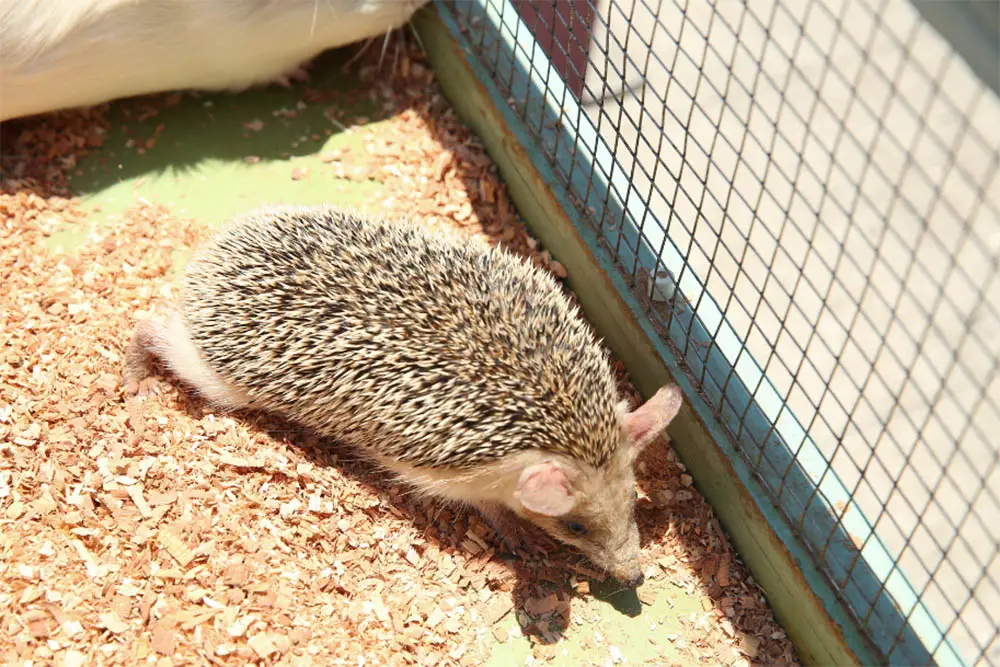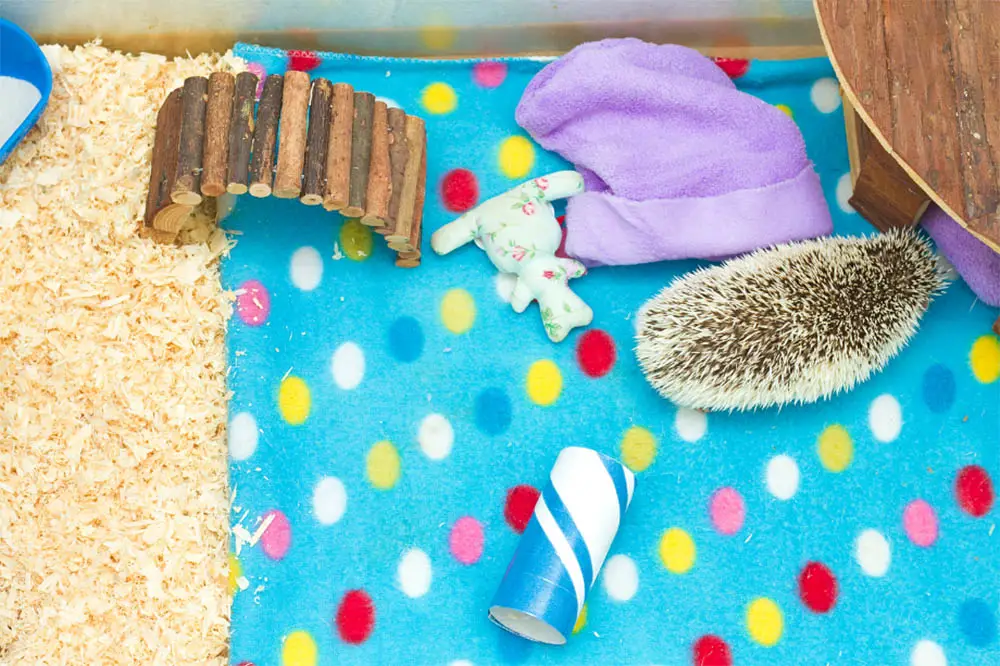There are several states where hedgehogs can legally be owned as pets. Whether you already own a hedgehog and are looking to upgrade its living space, or you have recently decided to bring one home, it is important to ensure that its cage is a safe environment.
All hedgehogs will require the basics such as a source of heat, bedding, a house to retreat to, a food and water bowl, an exercise wheel, and some toys to keep them entertained.

Of course, you may wish to add some additional accessories, but first, it is important to make sure that the cage is equipped with the basics.
We have created a guide below that will inform you of the correct way to set up your hedgehogs cage. We have also listed all of the essentials required along with some tips for choosing the best type of cage for your pet.
Choosing the right type of cage for your hedgehog
First, you must decide on a type of cage. There are many different options available, some of which are suitable for domesticated hedgehogs and others that are suitable for wild hedgehogs too.
Your hedgehog needs plenty of space to roam. If your hedgehog is restricted, it is more likely to become depressed and there is also a risk of it developing a health issue.
Ideally, the cage should be 2 feet by 2 feet, although anything larger than this is also sufficient as it will provide your hedgehog with plenty of space to explore.
You should also make sure that your hedgehog surroundings are visible and they can see out of the cage.
Furthermore, you must also ensure that the cage is properly ventilated and secure. If there are any gaps, or the loose isn’t fitted correctly, there is a greater risk of your hedgehog escaping.

The first option is a commercial pet cage. Should you opt for this type of cage, you must make sure that it is solidly structured. Commercial cages also tend to have a gap enclosure which means that they are well ventilated but also increases the risk of your hedgehog being able to escape.
The cage also needs to be large enough to accommodate your pet’s exercise wheel and accessories. Alternatively, you may choose to house your hedgehog in a playpen that is pet-friendly.
A great thing about playpens is that they can easily be moved around if necessary. The design of this type of cage needs to be suitable for your hedgehog. Again, some have wide bars that your pet may be able to climb out of.
If you do not wish to invest in a shop bought cage, you may prefer to create a DIY version. For example, you may wish to use an aquarium providing that it is large enough for your hedgehog to explore comfortably and can also house all of its necessities.
There are benefits and drawbacks associated with each different type of cage. Of course, ensuring that there is plenty of space for your hedgehog must be a priority, but you must also decide whether the look of the cage or how easy it is to clean is the most important.
Positioning your hedgehog’s cage
Once you have chosen a cage for your hedgehog, you will need to make sure that it is correctly positioned.
The placement of the cage can have an impact on the health of your pet. Ideally, your hedgehog should be housed in an environment where the temperature ranges from 74°F – 78°F.
Anything warmer than this can inflict unnecessary stress and anything colder may force them into hibernation. As such, you should place the cage away from windows, air conditioners, heaters, or drafty areas.
Essentially, anywhere where there is a risk of the temperatures changing quite drastically. Aside from this, you should also avoid placing the cage in rooms or near products that tend to be noisy.
Because hedgehogs have sensitive hearing, putting their cage in a noisy room can cause them to become anxious and you will likely find that they are reluctant to leave their houses to eat and explore their cage to play.
Heat Source
As the colder months approach, you must make sure that your hedgehog’s cage is equipped with a viable heat source. Fatalities can occur as a result of your hedgehog hibernating response to the drop in temperatures.
There are multiple products that you can choose to heat your hedgehog’s cage. A heat lamp can be used so long as the cage and its contents are not a fire risk.
For example, there may be materials that are susceptible to melting when exposed to heat. Secondly, you should also make sure that the light doesn’t emit any light because this is going to be a rather confusing concept for your hedgehog.
Another option is to use a heat pad, though you must make sure that the temperature can be regulated to prevent it from getting too hot. Many come with covers that will reduce the intensity of the heat output so that it isn’t too warm.
To monitor the temperature of the cage and ensure that it remains within the correct range you can keep a thermometer inside. This will allow you to check and control the temperature.
Lining The Cage
The base of the cage will need to be lined with one of the following materials; shavings, fabric, or paper. Wood shavings are the most favorable option as they are safe and readily available from the majority of pet retailers.
They may not appeal to some people because they can be a little messy. Alternatively, you may choose to line the bottom of the cage with some fabric.

As it is softer, it will be more comfortable for your hedgehog and it can also be cleaned and reused. Furthermore, you also have the option of using paper shavings. As they absorb urine fairly well they do not need to be changed as regularly as wood shavings.
The Best Type Of Bedding
The bedding will influence how comfortable and secure your hedgehog feels when they are in the cage.
It is important to note that certain types of bedding can be quite harmful to them. Gravel, cedarwood, and sawdust are harmful to hedgehogs, and because of this, you should avoid introducing them to the cage.
The material that you line the cage with can also double up as a bed as it is likely that most hedgehogs will burrow into it. Should you opt for fabric, you will need to ensure that it isn’t designed with any small holes because there is a risk of your hedgehog’s feet getting caught.
Some owners may also add a sleeping pouch or wooden house on top of the material that has been used to line the cage. This type of housing will provide your hedgehog with an area to retreat to when they want to feel safe and rest.
Food And Drink
Food and water play a crucial role in the survival of your pet. As hedgehogs have poor eyesight it needs to be easily accessible. You should also have 2 different bowls, one for their soft food and another for their hard food.
Their bowls should not be made from a material that contains any toxins. Furthermore, heavier bowls are going to remain more securely positioned and less likely to tip over and spill its contents.
Aside from this, you should also opt for bowls that are slightly raised because this minimizes the chance of their bedding getting into it. It is also recommended that you position your hedgehog’s bowls away from their litter box and exercise wheel.
Exercise
Hedgehogs love to run and so it is important to provide them with somewhere to burn off this energy. A lack of exercise accessories may lead to your hedgehog becoming overweight.
The surface of the wheel should be flat and wire-free as this eliminates the risk of their feet getting injured. Furthermore, it must also be sufficiently sized to cater to the size of your hedgehog. If it is not deep enough, your hedgehog is likely to fall out as they use it.
Toys
Toys can help to keep your hedgehog stimulated and entertained. Avoid choosing toys that have small parts as this presents a choking hazard. Also do not opt for toys that have been made using toxic materials.
It is likely that your hedgehog will enjoy playing with chew toys, small rubber balls, and robustly made plastic toys.
Final Thoughts
As you can see, there are many factors that you will need to consider when setting up your hedgehogs cage. First, you must make sure that you select the appropriate type of cage and place it in the correct area of your home.
Furthermore, you also need to make sure that the cage remains at the right temperature and contains all of the accessories that they need to survive and keep them stimulated.









